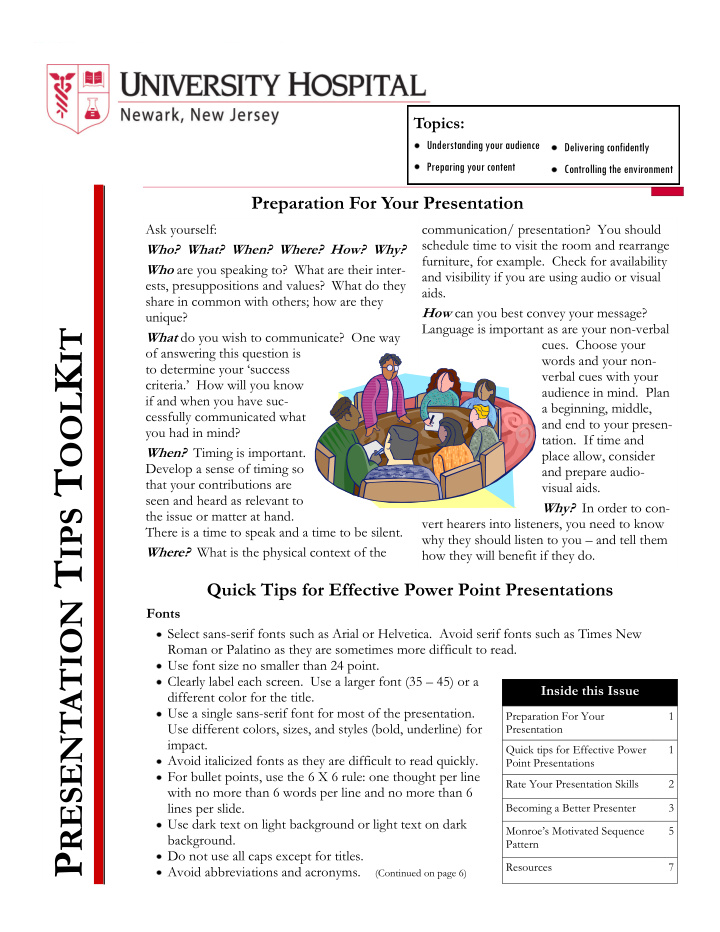



Topics: Understanding your audience Delivering confidently Preparing your content Controlling the environment Preparation For Your Presentation Ask yourself: communication/ presentation? You should schedule time to visit the room and rearrange Who? What? When? Where? How? Why? furniture, for example. Check for availability Who are you speaking to? What are their inter- and visibility if you are using audio or visual ests, presuppositions and values? What do they aids. share in common with others; how are they How can you best convey your message? unique? P RESENTATION T IPS T OOL K IT Language is important as are your non-verbal What do you wish to communicate? One way cues. Choose your of answering this question is words and your non- to determine your „success verbal cues with your criteria.‟ How will you know audience in mind. Plan if and when you have suc- a beginning, middle, cessfully communicated what and end to your presen- you had in mind? tation. If time and When? Timing is important. place allow, consider Develop a sense of timing so and prepare audio- that your contributions are visual aids. seen and heard as relevant to Why? In order to con- the issue or matter at hand. vert hearers into listeners, you need to know There is a time to speak and a time to be silent. why they should listen to you – and tell them Where? What is the physical context of the how they will benefit if they do. Quick Tips for Effective Power Point Presentations Fonts Select sans-serif fonts such as Arial or Helvetica. Avoid serif fonts such as Times New Roman or Palatino as they are sometimes more difficult to read. Use font size no smaller than 24 point. Clearly label each screen. Use a larger font (35 – 45) or a Inside this Issue different color for the title. Use a single sans-serif font for most of the presentation. Preparation For Your 1 Use different colors, sizes, and styles (bold, underline) for Presentation impact. Quick tips for Effective Power 1 Avoid italicized fonts as they are difficult to read quickly. Point Presentations For bullet points, use the 6 X 6 rule: one thought per line Rate Your Presentation Skills 2 with no more than 6 words per line and no more than 6 lines per slide. Becoming a Better Presenter 3 Use dark text on light background or light text on dark Monroe‟s Motivated Sequence 5 background. Pattern Do not use all caps except for titles. Resources 7 Avoid abbreviations and acronyms. (Continued on page 6)
Page 2 PRESENTATION TIPS TOOLKIT Rate Your Presentation Skills For each statement, circle the number that best describes you. Don’t worry if some statements seem to score in the “wrong di rec tion.” When you are finished, add together all the circled numbers for a total score. Statement Not Some Very At All Rarely times Often Often 1. The visuals in my presentation match well with the information I am 1 2 3 4 5 communicating and help support the message. 2. To prepare for my presentation, I think carefully about the message I 1 2 3 4 5 want to send. 3. Before I present, I become familiar with the room and the space in 1 2 3 4 5 which I will be speaking. 4. I plan and practice my presentation until I can speak comfortably and 1 2 3 4 5 fluently. 5. I assume my audience knows very little, and then I give them all the 5 4 3 2 1 information they need. 6. I use an indirect, subtle approach, and I send a gentle message to my 5 4 3 2 1 audience. 7. Anxiety gives me stress and brings negative energy to my presentation. 5 4 3 2 1 8. I make sure that organizers or other staff prepare my equipment so that 5 4 3 2 1 I can arrive right on time and start immediately. 9. I encourage my audience to ask questions at the end of the presentation. 5 4 3 2 1 10. I pay attention to my non-verbal behavior, like facial expressions and eye 1 2 3 4 5 contact, to make sure I stay engaged with the audience. 11. I use examples to support my points. 1 2 3 4 5 12. My presentations sometimes take longer than planned. 5 4 3 2 1 13. If I want to persuade an audience, I get them to think about what the 1 2 3 4 5 future will be like if they continue without making changes. 14. I focus on the main part of the presentation more than the beginning 5 4 3 2 1 and end because that is where most of the information is given. Total Score: _________ 14 -32 33 -51 52 -70 Your presentations are probably quite Your presentations are OK and they are Super job! You are giving excellent probably very typical of average present- weak and perhaps a little boring. There presentations. They are interesting ers. The impression you leave isn‟t are lots of ways to bring more excite- and well suited to the audience, and good or bad – it‟s essentially non - ment to what, and how, you present. you know that taking time to prepare existent and your message is likely soon You simply need more practice develop- forgotten. Use the tips in this TOOL- pays off in the end. Review the ing the right kind of content and learn- KIT to add life to your presentations so strategies in this TOOLKIT and ing to use your nervousness to create a that your audience remembers you for challenge yourself to continue im- all the right reasons. positive flow of energy. Read this proving your presentation skills. TOOLKIT for tips on building your self-confidence. (Adapted from www.Mindtools.com)
Recommend
More recommend